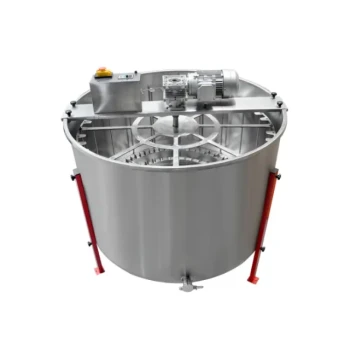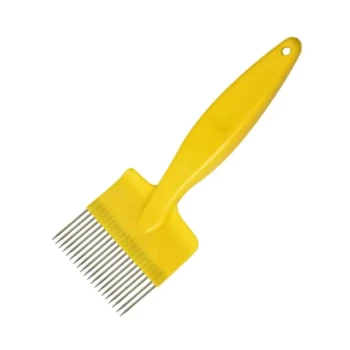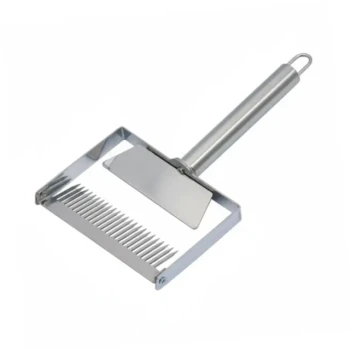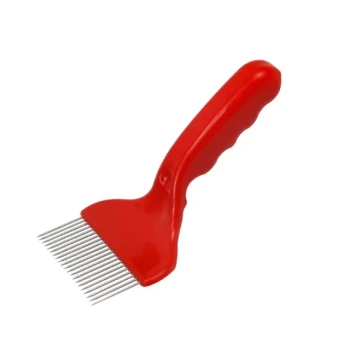To extract honey without a centrifuge, the most common and accessible method is known as "crush and strain." This process involves scraping the honeycomb from its frame, crushing it to break open the wax cells, and then allowing the raw honey to drain through a filter, separating it from the beeswax.
The method you choose depends entirely on your equipment. The "crush and strain" method is necessary when you don't own a centrifugal extractor, but it requires destroying the comb. The alternative, "cut comb," is for consuming the honey and wax together and is only suitable for foundationless frames.
The Two Core Methods Explained
When you forgo a mechanical extractor, your choice is dictated by the type of frames in your hive and your end goal for the honey.
The Crush-and-Strain Method
This is the most direct way to separate liquid honey from its wax comb without a centrifuge. It's a simple, albeit messy, gravitational approach.
You begin by cutting or scraping the entire honeycomb away from the frame's foundation. If you have a sturdy plastic or reinforced wax foundation, you can save it to be placed back in the hive for the bees to rebuild on.
Next, you crush the comb. This can be done in a large, food-safe bucket or bowl using a potato masher or a similar blunt instrument. The goal is to break open every sealed honey cell.
The crushed mixture of honey and wax is then poured into a sieve or colander lined with a filter. You can use cheesecloth, a dedicated honey filter, or even a clean pair of nylon stockings. The container is then left for several hours, or even overnight, allowing gravity to slowly pull the honey through the filter into a clean bowl below.
The Cut-Comb Method
This approach isn't truly "extraction," but rather a method of preparing honey to be eaten with the wax. It is the purest way to enjoy honey, exactly as the bees made it.
This method is only suitable for frames that have no internal foundation or use a special, ultra-thin wax foundation designed to be eaten. Using a sharp knife, you simply cut neat squares or rectangles of capped honey directly from the frame.
These pieces of "comb honey" are a delicacy and are consumed as a whole unit, wax and all. The wax has a pleasant, chewy texture and is completely edible.
Refining and Storing Your Harvest
Once the honey is separated, a few final steps will ensure it has the best clarity and shelf life.
The Importance of Straining
Straining is non-negotiable in the crush-and-strain method. It removes all the large pieces of beeswax and other hive debris (like propolis or bee parts) that get mixed in during the crushing process.
A double-sieve system, with a coarse filter on top of a finer one, often works best to prevent the finer filter from clogging too quickly.
Using Gravity for Finer Clarity
Even after straining, your honey may contain microscopic particles of wax and pollen. For crystal-clear honey, you can let it settle.
Pour the strained honey into a bottling bucket, which has a spigot or "honey gate" at the bottom. Let the honey sit undisturbed for several days to a week. During this time, the lighter wax particles and air bubbles will slowly rise to the top, forming a foam.
You can then bottle crystal-clear honey directly from the gate at the bottom, leaving the foamy layer behind.
Understanding the Trade-offs
While extracting without a centrifuge is simple and cheap, it comes with significant considerations that impact your bees.
Pro: Low Cost and Simplicity
The most obvious benefit is financial. You avoid the cost of a honey extractor, which can be several hundred dollars. The crush-and-strain method requires only basic kitchen equipment.
Con: The Beeswax is Sacrificed
This is the single biggest drawback. Bees expend a tremendous amount of energy and consume a significant amount of nectar (estimated at 8 pounds of honey for 1 pound of wax) to build their comb.
When you use a centrifuge, the empty comb remains intact and can be returned to the hive. The bees can immediately start refilling it, leading to a much faster and larger subsequent honey harvest. The crush-and-strain method destroys this valuable resource, forcing the bees to start from scratch.
Con: It's a Slower, Messier Process
Centrifugal extractors are fast and relatively contained. The crush-and-strain method is sticky, requires more manual effort, and takes many hours for the honey to fully drain.
Making the Right Choice for Your Goal
Your approach should align with your scale, your equipment, and your long-term beekeeping philosophy.
- If you are a new hobbyist with only a few frames: The crush-and-strain method is a perfect, low-cost way to get started and enjoy your first harvest.
- If you use foundationless frames: Preparing and enjoying your harvest as cut comb is the ideal approach that honors the nature of your hive.
- If your goal is to maximize honey production: You should plan to eventually invest in an extractor to preserve the bees' drawn-out comb.
Ultimately, successfully harvesting honey is a rewarding experience, and these methods ensure it is accessible to every beekeeper, regardless of their budget.
Summary Table:
| Method | Best For | Key Consideration |
|---|---|---|
| Crush and Strain | Extracting liquid honey from any frame | Destroys the honeycomb |
| Cut Comb | Consuming honey and wax together | Requires foundationless frames |
Ready to upgrade your beekeeping operation? Whether you're a commercial apiary or a distributor, HONESTBEE supplies the durable, high-quality equipment you need to scale your honey production efficiently. From extractors to bottling buckets, we provide the wholesale solutions for professionals. Contact our team today to discuss your needs!
Related Products
- 2 Frame Stainless Steel Manual Honey Spinner Extractor for Beekeeping
- 6 Frame Manual Stainless Steel Honey Extractor Beekeeping Equipment
- HONESTBEE 72 Frame Industrial Electric Honey Extractor for Beekeeping
- electric honey extractor honey centrifuge 3 frame honey extractor stainless steel honey frame extractor
- Plastic Hand Crank 2 Frame Honey Extractor Low Price
People Also Ask
- What are radial honey extractors and what are their features? Maximize Your Honey Harvest Efficiency
- What is the basic principle of the honey extractor? Harness Centrifugal Force for Efficient Harvesting
- How does a manual honey extractor work? A Guide to Gentle, Efficient Honey Harvesting
- What is the role of a honey extractor? Maximize Honey Yield & Protect Your Bee Colony
- How does centrifugation work in honey extraction? The Sustainable Method for Modern Beekeepers



















